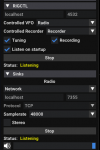That worked perfectly for me! Thanks a million for finding that workaround so quickly.Okay, I figured out something, its related to the auto gain. If you use the -g option and pick -1 it will disable auto gain, or you can use something like -g 1 or -g 2 then it'll play them again. I'll have to review the auto gain function again, seems like I did some things to it when working on the crackling/auto smoothing stuff a little while back.
This command worked for me, but you'll need to adjust it based on your own usage.
dsd-fme -g -1 -r mbefiles/*
This might be a really stupid question but do the -K and -H options work with -r playbacks? The output audio sounds exactly the same to me, regardless of the key. I would expect it to alter with different keys.
Also when using the -H option, the **tera Key is shown but when using the -K option there is no mention of it during program exection. That is regardless of whether it is in live mode or playback mode with both Full and Lite versions. Again, maybe that is expected behaviour.







